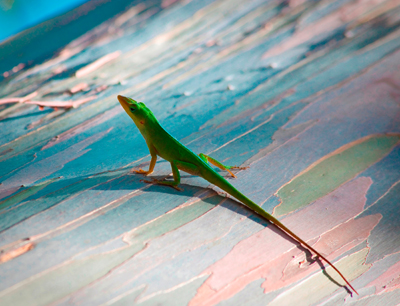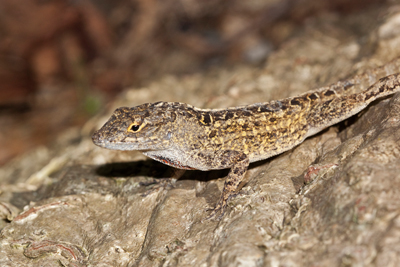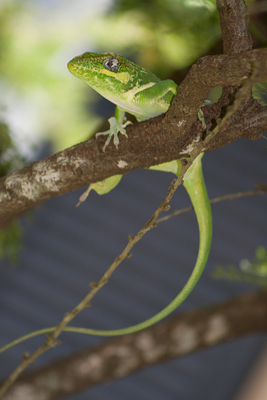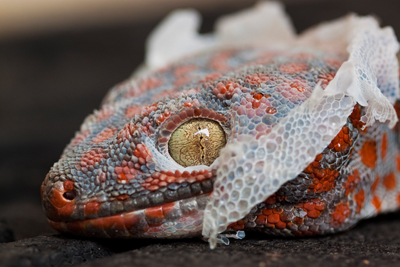Get to know your friendly neighborhood lizard

BY KENNETH SETZER
As published in the Miami Herald, 11/6/14.
As a gardener, you undoubtedly encounter many lizard visitors in your yard. Knowing a little about who they are will enrich your outdoor experience, and possibly increase your appreciation of these little dinosaurs.
Our most common garden lizards are the anoles; Anolis is indeed a very large genus.
I think my favorite anole is also our only native, the Carolina anole, sometimes called a chameleon, though it’s not one. Anolis carolinensis often appears a cheerful bright lime green, though it can change color to an olive green or dull brown for a variety of reasons, ranging from camouflage to mood or body temperature. Males are usually larger than females, and their dewlaps (flap of skin under the lizard’s head) are pinkish-red, while the female’s dewlap is white. The dewlap can be extended and displayed along with head bobbing when defending territories or attracting a mate. Carolina anoles are mostly arboreal; better to be up and away from cars, feet and cats. They are mostly insectivorous, but will occasionally take to fruit. Like many lizards, they can escape by “losing” their tail if grabbed by it, or to throw off a predator that may just follow the wiggling, disembodied tail while the anole escapes. This ability is called autotomy.
Anolis sagrei, the common brown anole, is everywhere—and it’s comfortable in trees or on the ground. If you see a small, gray-brown lizard, it’s likely this anole. Native to the Caribbean, they’ve spread well beyond throughout the Southeast and Hawaii. One reason for their success might be their diet: they eat practically anything including other lizards and their eggs. I’ve read that these invaders have lowered the population of native Carolina anoles, and pushed them up to lead a more arboreal life away from the brown anoles on the ground, but no studies regarding this competition seem conclusive. Besides color, brown anoles differ from Carolina anoles in having a small ridge down their backs, which in females and juveniles may be tan. They also often reveal a tan diamond or chevron pattern along with yellowish dots. Their dewlaps vary from red to yellow, with a lighter edge. These guys are certainly resilient; I can tell you with certainty—don’t ask me how—that a brown anole can survive in one’s luggage for a flight lasting many hours.
Anolis distichus, the bark anole. This one spends lots of time on tree trunks. It’s a fairly unassuming gray-brown, without the distinctive markings of the brown anole. However its dewlap can be a striking pale yellow-green. Some online descriptions report them as changing color to a pale green. I’ve never seen a green bark anole, but who knows what sort of interbreeding is possible.
Anolis cristatellus (Puerto Rican crested anole), another introduced anole that almost always stays off the ground. This one can be somewhat reddish, varying to brown and nearly black. I love these lizards because the crest running down their backs makes them look very much like the unrealistic bright red plastic dinosaur toys I used to have (and wish I still did). There’s a little raised ridge of skin surrounding the crested anole’s eyes; it gives this anole a sort of beseeching, almost concerned look.
A standout among anoles is the knight anole, Anolis equestris. This one’s huge compared to the other anoles, easily reaching a good foot long or more. Their heads appear flattened and wedge shaped. You can’t miss them; they are a vibrant bright green with yellow stripes under the eyes. The knight anole is native to Cuba, and can’t withstand much cold. Given lower temps, and you’ll find them in a torpor having fallen from the trees they inhabit. These anoles are fiercely territorial and will stare you down. But get too close, and they will predictably crawl to the other side of whatever tree trunk they are on. The reptilian brain at work—if you can’t see them, they must be gone. Knights eat primarily insects, but will grow to consume other lizards, birds or anything they can fit into their gaping maws. They lay their eggs in the ground, often at the base of a tree. I’ve uncovered hatchlings while digging in the garden, a startling encounter.
Now on to evening: when anoles go to sleep (most) geckos are just waking up. It’s safe to say we have a glut of gecko species in the Southeast, and it gets very confusing. Given their sticky appendages, you’ll likely see Hemidactylus turcicus, the Mediterranean house gecko, hanging out around light fixtures and chasing down moths, even upside down on ceilings. This gecko looks quite similar to the common house gecko (Hemidactylus frenatus); both have “warty” pink, almost translucent skin. It seems geckos are indeed world travelers, evidenced by the Indo-Pacific house gecko (Hemidactylus garnotii) from Southeast Asia and the tropical house gecko (Hemidactylus mabouia) which originates in sub-Saharan Africa; the latter species is thought to be overtaking the other gecko species in South Florida. Some geckos, like the Indo-Pacific, can reproduce by essentially cloning themselves, a process called parthenogenesis—no male needed!
And now to the giant among them, the tokay gecko (Gekko gecko), with females growing up to 18 inches long. The tokay is pale blue with orange “warts” and yellow, unblinking eyes, but are quite shy and nocturnal. However you can’t miss their vocalizations! Tokays “talk” to each other with a loud “uh oh, uh oh,” and love eating roaches. If you are very lucky, you may spot our only native gecko, the two-inch reef gecko (Sphaerodactylus notatus), hanging out in leaf litter.
Last but not least is the much-maligned green iguana (Iguana iguana). Why so much hate for this beautiful green dinosaur? Well, I believe it’s because while the anoles and geckos eat bugs, iguanas eat plants. And so do we. You probably won’t see iguanas in your yard unless you are somewhere near water. They love to bask on branches overhanging canals and lakes, where they can escape if threatened.
These lizards, plus the many others in our region, are really harmless to us, plus they eat lots of bugs—friends in my book.

Our native Carolina anole

The very common brown anole

The large knight anole

A shedding tokay gecko
